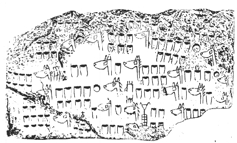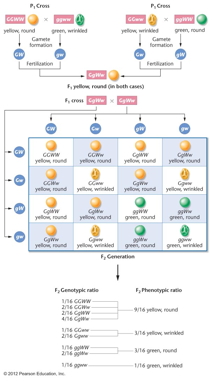Pre-Mendelian
Concepts of Heredity: In order to understand
the true significance of Mendel's contribution to the
understanding of heredity, we need to have an idea of the
mistaken ideas that were common in his day. (Note: the concept of
heredity is not new; James
used a genetic example). Pre-mendelian mistaken ideas
include:
- Spontaneous
Generation: This widely held idea said that
new life continually arises from non-living material.
This idea is a denial of the concept of heredity. It
was disproved by Redi and Pasteur.
- Preformation:
A tiny preformed human, a homunculus, is present in
one of the gametes: if so heredity would come from one
parent only.
- The
Inheritance of Acquired Characteristics: The
idea that traits acquired during an organisms lifetime
can be passed along to the offspring. One example is
Lamarck's theory--Lamarckism.
- The
Blood as the Hereditary Material: The genetic
material is in the blood (or sap) and crossing mixes
the blood of two organisms.
|


|
| Mendel: Gregor Mendel
was an Augustinian Monk who became known as the "Father of
Genetics." In the monastery garden, his experimental
organism was the garden pea, which was available to him in
many varieties, produced many offspring, and could be
selfed (self-crossed) as well as crossed. |
|
- Monohybrid
Cross: Mendel first crossed strains of
peas differing for one trait (e.g.: round seeds x
wrinkled cotyledons).
- Results: When
tall plants were crossed with dwarf plants (P
generation), the next generation (F1 generation)
were all tall like the P generation. When the F1
generation plants were selfed the result F2
generation consisted of 787 tall and 277 dwarf.
- Conclusions: Mendel drew at least
three conclusion from his monohybrid crosses.
- Pairs
of Factors: Each individual has
a pair of factors for each trait.
- Dominance:
If an individual has two different factors, one
will be expressed (the dominant one) and one will
not (recessive one).
- Segregation:
When the individual produces gametes, the pair
separates with one going to each gamete (Law of
Segregation).
|
 |
- Terminology:
Today, we used the following terms.
- Gene,
allele:
The factors Mendel described are called gene. A pair
of factors are alleles.
- Dominant,
recessive:
When two different alleles are present, the
expressed on is the dominant allele. The one that is
not expressed is the recessive allele.
- Genotype,
phenotype:
The genotype is the genetic make up, usually
expressed by designating symbols for the genes (DD,
Dd, and dd are examples of genotypes). The phenotype
is the expression of the genotype ("what you
see")(yellow seeded and green seeded are examples of
phenotypes).
- Homozygous,
heterozygous:
An individual with two identical alleles is
homozygous. An individual with two different alleles
is heterozygous. (AA is homozygous dominant, aa is
homozygous recessive.)
- Reciprocal
cross, test cross, back cross:
A cross in which the sex of two parents is reversed
(not a sex-change operation) is a reciprocal cross.
(Tall female x dwarf male is the reciprocal cross
when compared to dwarf female x tall male.)(Mendel
did reciprocal crosses for all his crosses.) A test
cross is a cross to a homozygous individual (e.g.,
Aa x aa), usually done to determine the genotype of
an unknown individual. A back cross is a cross to an
individual with the same genotype as one of the
parents.
QUIZ: What are these?
|
- Dihybrid
Cross:
Mendel next crossed pea plants that differed with
respect to two traits (e.g. yellow-, round-seeded
plants x green-, wrinkled-seeded plants).
- Results: When yellow-seeded,
round-seeded plants were crossed with green-seeded,
wrinkled-seeded plants, the F1 were all yellow
seeded and round seeded. When the F1 were selfed,
the F2 were: yellow, round = 315; yellow, wrinkled =
108; green, round = 101; green, wrinkled = 32.
 
|
- Conclusions:
Mendel drew one conclusion from his dihybrid crosses.
- Independent
Assortment: The
segregation of one pair of alleles is independent of
the segregation of another pair of alleles (Law of
Independent Assortment).
Correns,
deVries, Tschermak: In
1900, these three discovered Mendel's article and made his
work known to the scientific world. (Revision
of the early history of genetics: Two Tschermaks)
Mendel's Data:
When Mendel's data is carefully analyzed, it looks too
good. Did he fudge his data?
Answer to Quiz.
|
mendel_files/css3menu20/bhome.png) Home
Home
